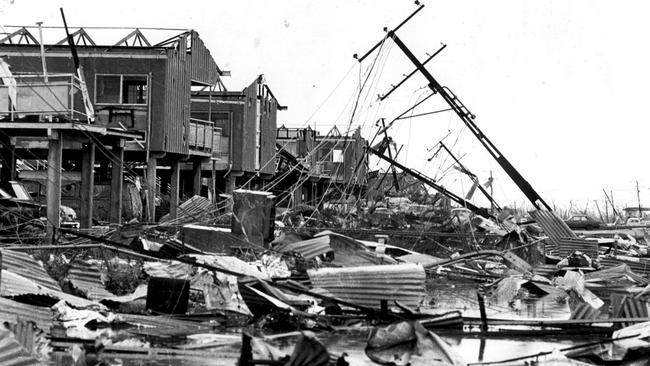Deadly Christmas as Tracy flattened Darwin
Forty years ago as cyclone Tracy turned sharply towards Darwin, staff at the Darwin Weather Bureau were enjoying a Christmas party.

Today in History
Don't miss out on the headlines from Today in History. Followed categories will be added to My News.
CYCLONE Tracy, observed by meteorologists a day earlier as a depression in the Arafura Sea, lay well north of Darwin when it formally came into existence at 10am on December 21, 1974.
It moved slowly southwest and intensified the next day, passing close to Bathurst Island on December 23 and into Christmas Eve.
Forty years ago, as Tracy turned sharply east-southeast heading straight for Darwin, staff at the Darwin Weather Bureau were enjoying a Christmas party. At the other end of the room, colleagues assigned to the cyclone warning centre were intently monitoring radar images of neat spiral bands off the city coastline.
The Northern Territory cyclone season had started three weeks earlier when a low pressure system 350km north in the Timor Sea developed into cyclone Selma. Two days later, with Selma 100km away, the Bureau of Meteorology issued alerts, warning residents to prepare for a potentially devastating storm.
Then, at 10am on December 3, Selma moved north and west, away from the city. Although she dumped plenty of rain and blew down trees, damage was limited. When warnings about Tracy began, many residents continued celebrating Christmas in a widespread belief that Tracy would mimic Selma.
Development in Australia’s northern city had been slow from 1863, when British colonial authorities created the Northern Territory of South Australia as a centre for trade with Asia. Explorer John McDouall Stuart had forged a passage across the continent only a year before.
Dutch sailors who visited the coastline from the 1600s drew the first European maps, bestowing names such as Arnhem Land and Groote Eylandt. Commander John Wickham sailed British vessel HMS Beagle into the harbour in September 1839, naming the port after naturalist Charles Darwin, his colleague on an earlier expedition.
The harbour foreshores were occupied by at least 700 Larrakia Aborigines when South Australian surveyor-general George Goyder arrived with 120 men in February 1869 to lay out a town and port called Palmerston, after the then British prime minister.
Australian Overland Telegraph Line workers found gold in 1871 while digging post-holes 230km south at Pine Creek, spurring a rush to the north. Chinese migrants supplied cheap labour to build a railway line from Port Darwin to Pine Creek in the 1880s.
Tensions flared from December 1888, when new South Australian laws stopped Chinese immigration, although employers favoured reliable Chinese workers.
A “great hurricane” hit the town, then huddled on a peninsula, on January 6, 1897. The cyclone coincided with a high tide, causing a storm surge that killed 15 people.
The Larrakia, who traditionally moved inland as bird and ant behaviour indicated the approach of wild storms, attributed cyclones to human actions or failures which provoked the fury of Nungalinya, or Old Man Rock, off Casuarina Beach. An angry Nungalinya retaliates with earthquakes, storms and cyclones.
As unskilled Europeans struggled to find work, in 1912 labourers established the Darwin Australian Workers Union and backed a general strike in 1913 after the government lowered wages for some workers. Another severe cyclone hit in 1917 but did not deter British conglomerate Vestey Brothers from opening a meatworks, although AWU members staged regular strikes for higher wages.
Labour and self-government disputes escalated on the afternoon of December 17, 1918, after stopwork meetings in Darwin and at Vesteys. About 1000 men walked to Government House carrying an effigy of territory administrator John Gilruth, tied to a stake.
Another damaging cyclone struck in 1937.
In 1942 the city, then home to about 10,000 Australian and Allied troops, was evacuated after 188 Japanese warplanes attacked in two waves. From 9.57am on February 19, the same Japanese fleet that had bombed Pearl Harbour dropped even more bombs on Darwin, killing at least 243 people and causing extensive damage.
Darwin, officially named in 1911, expanded rapidly from 1956 and was declared a city in 1959.
As Tracy rounded Bathurst Island’s western tip, Darwin was home to about 48,000 people.
By late afternoon on Christmas Eve 1974, Darwin was cloaked by heavy, low cloud and lashed by intensifying rain squalls and winds. Winds caused damage from 10pm and intensified by midnight, buffeting cars as young revellers made their way home.
Winds hit 217km/h before the anemometer at Darwin Airport was destroyed. Over the next six hours Tracy destroyed 8000 of 12,000 homes, cut communications and claimed 71 lives.
Blown Away, ABC TV, 8pm December 23.


